Charleston, SC Pollen and Allergy Report for Summer 2023
Pollen Allergy Trends in Charleston, SC
When is pollen lowest in Charleston, SC?

February
Lowest month total PPM
Avg. PPM
When is pollen highest in Charleston, SC?

April
Highest month total PPM
Avg. PPM
How does pollen in Charleston, SC compare to South Carolina?
Charleston has a lower average PPM than the state of South Carolina.
Charleston yearly avg PPM:
South Carolina yearly avg PPM:
How does pollen in Charleston, SC compare to the USA?
Charleston has a higher average PPM than the USA.
Charleston yearly avg PPM:
USA yearly avg PPM:
Is pollen worse this year in Charleston, SC?
Spring 2023 was better than spring 2022.
Spring 2023 PPM:
Spring 2022 PPM:
Average PPM in Charleston, SC


Charleston, SC Pollen and Allergy Breakdown by Month
Grass
When is grass pollen highest in Charleston, SC?
April has the highest grass pollen in Charleston, SC with an average PPM of
When is grass pollen lowest in Charleston, SC?
December has the lowest grass pollen in Charleston, SC with an average PPM of
Tree
When is tree pollen highest in Charleston, SC?
March has the highest tree pollen in Charleston, SC with an average PPM of
When is tree pollen lowest in Charleston, SC?
October has the lowest tree pollen in Charleston, SC with an average PPM of
Weed
When is weed pollen highest in Charleston, SC?
April has the highest weed pollen in Charleston, SC with an average PPM of
When is weed pollen lowest in Charleston, SC?
February has the lowest weed pollen in Charleston, SC with an average PPM of
Charleston, SC Pollen Monthly Breakdown by Pollen Type


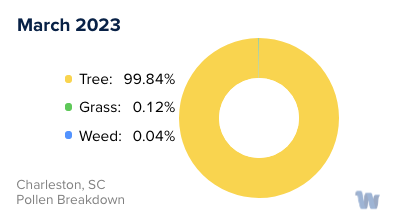
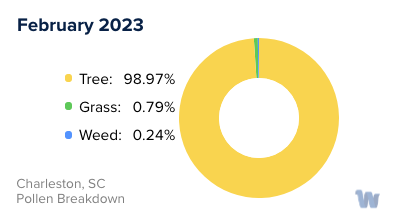
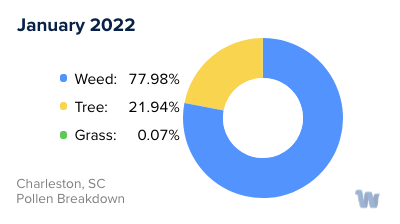
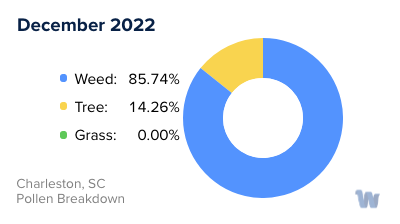
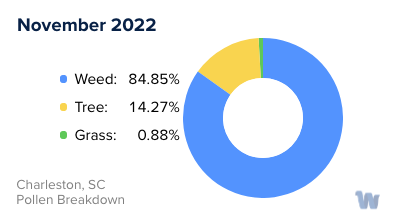

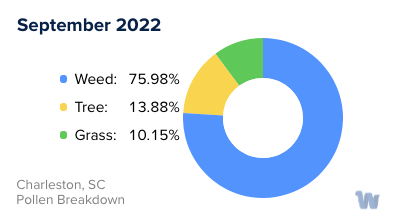
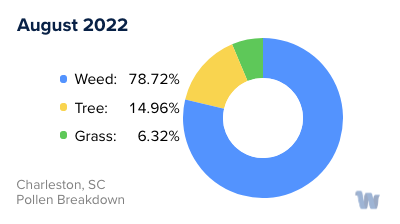

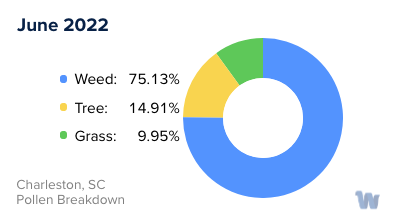
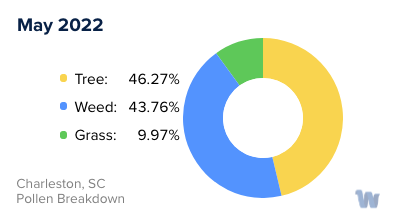
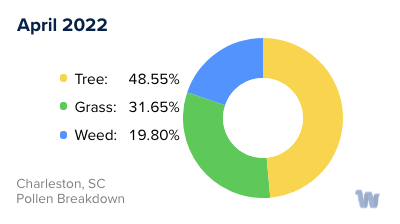

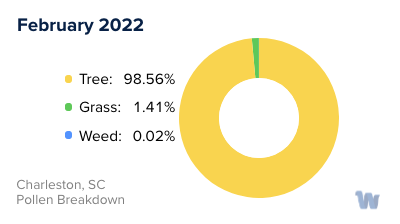
Pollen and Hay Fever in Charleston, SC
In the scenic city of Charleston, South Carolina, the beauty of changing seasons brings with it the discomfort of pollen allergies for many residents. Known medically as Allergic Rhinitis or "Hay Fever," pollen allergies affect millions of people across the United States, and the Lowcountry region of South Carolina is no exception.
In Charleston, the pollen season is significantly longer than in other regions, starting as early as late January and extending into the warm summer months. This extended season is largely due to environmental shifts caused by climate change, which have intensified pollen seasons not just in Charleston, but around the globe.
Spring, with its buzzing bees and blooming flowers, is the starting point of the pollen season. Contrary to popular belief, the pollen that triggers allergies is not from the vibrant flowers or the yellow pollen visible to the naked eye. Instead, it's the invisible pollen from certain trees that causes allergies to flare up. During early spring, the main culprits are elm, juniper, oak, cedar, and cypress trees. As we move into later spring, pine, oak, birch, walnut, and hickory trees take over. While pine pollen is the most prevalent, it is also the least allergenic; birch and oak pollen tend to be the worst offenders for allergy sufferers.
As spring transitions into summer, pollen remains a significant cause of allergies. This time, however, the source shifts from trees to grasses. This marks the second of the three common pollen seasons in Charleston: spring for trees, summer for grasses.
Fall ushers in the third and final phase of Charleston’s pollen season. During this time, allergies to weed pollen, particularly ragweed spores, become most prevalent. The autumn months also see an increase in outdoor mold levels, due to the Lowcountry's extended warm season and high humidity.
As the winter months approach and temperatures fall, the extended pollen allergy season finally comes to an end. However, this doesn't necessarily mean relief from allergies altogether. More time spent indoors can lead to exposure to year-round allergens such as mold, pet dander, and dust mites.
In Charleston, the scenic beauty of the changing seasons and the rich diversity of flora bring a unique blend of pollen types across different seasons. Being aware of these changes and the prevalent types of pollen can help residents better understand their allergies and navigate the extended pollen season.

